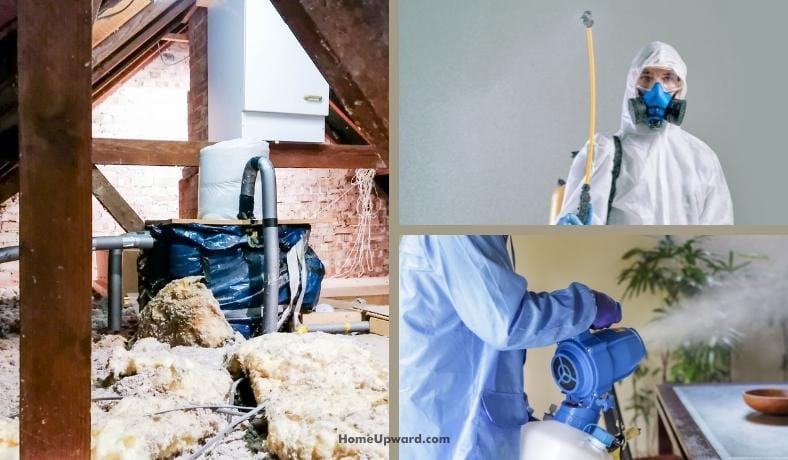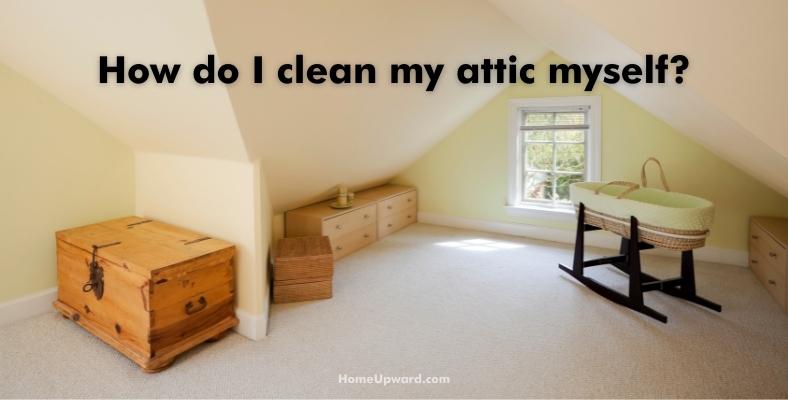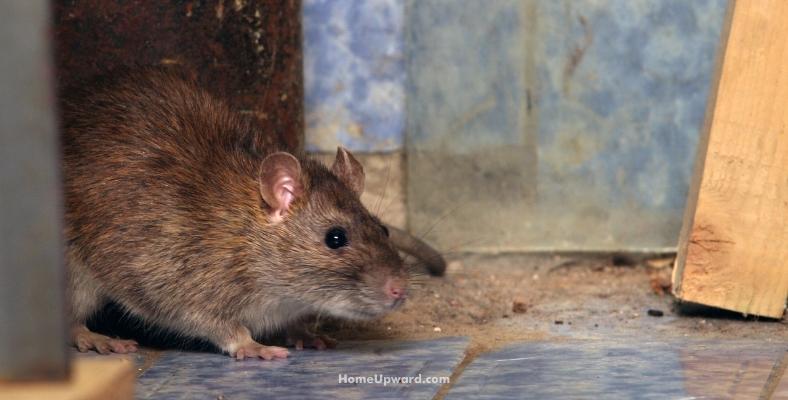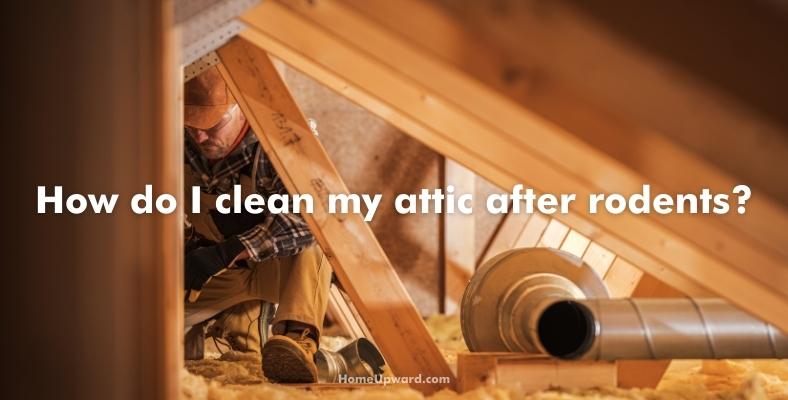Contents
Attic Decontamination Basics To Know
What is attic cleanup and decontamination?
Decontaminating and cleaning up your attic isn’t just about cleaning out old junk, things you don’t want anymore, or making it “less dirty.” Do it yourself (DIY) or professional attic cleanup usually means do a number of things like:
- Debris removal and junk removal.
- An assessment of the health and adequacy of your insulation.
- The identification, removal, and decontamination of rodent infestations.
- Addressing a rodent problem and proofing the attic space.
- Removing old or contaminated insulation.
- Installing new insulation or adding additional types of insulation.
- Identifying a leaky or damaged roof.
- Identifying and remediating mold.
- Debris removal and dust control.
If you’ve got an older house or haven’t taken care of your attic in years there’s a good chance at least several of these need attention. It’s also a great opportunity to consider upgrades. For example, you could add a radiant barrier to reduce energy costs even more.)
Why Is Attic Decontamination and Cleanup Important?
The truth is that most people don’t pay much attention to the condition of their attic, leaving it dormant for months or years at a time. Unfortunately, animals, rodents, pests, and mold can happen over time.
Mold spores and fungi can cause unpleasant or dangerous air quality and breathing conditions. If your attic is infe sted with mice, rats, birds, or other pests that can also mean you’re exposed to health risks from their feces and urine. Rat droppings have been known to transmit some nasty diseases, in fact!
Decontaminating your attic is also a good opportunity for you to boost energy efficiency in your home. Attic insulation is imperative to preserving the temperature in the house and helping to keep you comfortable (in addition to keeping energy costs down) so it’s not something to ignore.
For example, on hot days insulation can help keep the cool air inside while on cold days it helps keep the warm air inside. During attic cleaning you may need to or sprucing up any contaminated, soiled, or damaged insulation.
How Do You Decontaminate An Attic?
There are a couple of ways to do attic decontamination. One option is to get it done professionally and call an attic cleaning service like the Attic Guys.
Alternatively, if you are working with a tight budget or feel up to the task yourself, there are also DIY solutions. Some tips and tricks will be listed below.
How Much Does Professional Attic Decontamination Cost?
In general, decontaminating your attic after rodents or pests have been removed will cost about $1.50 per square foot. The cost of a full decontamination ranges from $1,000 to $5,000 on average.
The cost to hire a professional attic decontamination services can vary as it’s based on a number of factors. Two primary things determine the price:
- One is the size of the attic.
- How extensive the damage is.
The bigger the attic and the worse the damage is, the more time the task will take, and the higher the attic cleaning cost will be. The good news is that you can get a quote that’s fairly accurate in order to be prepared and find out if it’s in your budget.
How Do I Clean My Attic Myself?
Can You Clean An Attic Yourself?
The great news is that it’s possible to decontaminate an attic yourself without the help of a professional service.
Steps For Good Attic Cleaning
Remove everything
Clutter can make it difficult to see what needs to be done. Needless objects around the attic can also hide potential health hazards such as rodent feces. Remove everything out of your crawlspace (within reason) and you’ll set yourself up for a smooth attic cleanup.
Wipe away every bit of dust
Dust tends to collect on objects and in rooms that go long periods without use – which would likely include the attic. Make sure to wipe away any dust that has built up on any walls, windows, light fixtures, wooden beams, or other fixtures occupying the attic space.
Reach into all of the crevices to ensure there’s no dust left over. Wearing a mask might help to avoid breathing issues during this process, too, especially if you have allergies. It’s also a great idea if you’ve had a rodent problem because of diseases their urine or feces can spread.
If you’re having problems with hard-to-reach areas a long duster made for tall items can do the trick.
Vacuum & sweep
Although it might be tempting to go straight for the broom while cleaning the attic, it’s usually more efficient to vacuum first. A vacuum will help suck up all the debris and dust rather than release it into the air.
After vacuuming, take the broom and sweep up any remaining mess. Note: Always keep the vacuum cleaner filter in place otherwise it will blow dust and nastiness right back out around you in the air.
Inspect your insulation
Over time, attic insulation can easily become damaged. Inspect it to ensure that pieces aren’t missing, contaminated, or damaged. If the insulation appears damp or moldy it’ll probably have to be replaced.
Air often circulates through the insulation before reaching the rest of the house, and soiled insulation can cause a breathing hazard. Good quality insulation helps to keep hot and cold air circulating within the home.
Insulation tends to have a life of about 15-20 years before it’s time to replace it in order to help keep heating & cooling costs under control. Insulation can begin to lose its effectiveness after a long time.
Check for moisture and mold
Mold grows in moist, dark spaces. It’ill be easier to spot mold growing in the nooks and corners of the attic now that it has been fully emptied. The spores can be dangerous to breathe in, particularly for individuals with preexisting allergies or breathing conditions.
You can have a professional service deal with the mold or do it yourself using bleach and water if the damage isn’t too great. Drywall or wood, etc., with deep & significant mold growth may have to be replaced to eliminate it.
Check for preventative maintenance opportunities
While you’re up there, it’s a great time to look for other things you need to do. For example:
- Look for deteriorating wood or materials before they become unsafe or fall apart.
- Check for areas where drafts of air might get through causing an increase in heating and cooling costs.
- Look carefully for droppings or other signs of rodent infestations.
- Inspect your attic and any crawlspaces for water, wetness, condensation, or leaks from the roof or frames.
Sort and organize
This goes back to step 1 where you removed all of your belongings from the attic. At this point it’s time to sort through those belongings and organize them neatly.
- Decide what items to keep and what items might be disposable.
- Prepare to store everything necessary in your attic.
- You can use large plastic storage containers to keep precious or antique items safe and easily stackable. It makes moving easier as well!
Get rid of clutter you don’t need
Objects in storage spaces like attics and basements can build up over time, often unconsciously. Take the time to decide what you should throw away and what might be salvaged and donated.
Personally, I’m a big fan of taking a “minimalist” approach – for each item I ask if I really need it or not. If the answer is “no”, in nearly all cases I sell it, donate it, or give it away.
Replace items in an organized way
Now, optimize your attic space as you organize all the remaining objects in an orderly way. Take care to wrap anything that might otherwise become damaged or worn down.
This is a great opportunity to use basic stick-on labels and a permanent marker to label everything so it’s easy to find in the future. If you really want to get seriously organized you can make a list of what’s in the attic and where it is (in which general area).
An Excel spreadsheet or just old-fashioned notes are great for this.
Clean your attic cleaning a seasonal routine
Cleaning and decontaminating the attic only becomes difficult when the attic is left for a long period. Don’t let that happen again. Make attic cleaning a more regular affair – once per year or every two years is a great schedule.
Cleaning even just once every six months can prevent damage, mold, and pest issues so it’s less work than if you were to wait until later.
Can Rat Droppings In The Attic Make You Sick?
Rat feces can make you sick if you breathe them in or touch them. That’s because rats can carry diseases and parasites. Because of this you’ll want to be sure and handle them safely.
Rat droppings are typically about ¼ inch long and light brown. If you find any the droppings will likely be all over the place and not neatly deposited in one corner for example. You can expect to find some hidden behind objects and in crevices, too.
How Do I Clean My Attic After Rodents?
How To Clean Rodent Droppings In Your Attic
Remove the rat droppings and urine
- Spray any rat waste with a disinfectant and allow it to sit for approximately five minutes. A spray bottle is great if you’d like to use bottled disinfectant easily to cover a lot of area quickly.
- Then, using gloves, pick up the droppings rather than vacuuming or sweeping them up. Using a vacuum or broom can create more of a mess, spreading the feces instead of neatly depositing it.
- Make sure to wear a mask during this process as it can be dangerous to breathe in rat feces.
Dispose of dead rodents
Keep the protective gear in place, pick up the dead rodents, and dispose of them in a tightly wrapped plastic bag. Spray the surrounding area with disinfectant and again allow it to sit for about five minutes.
Check for exposed insulation
Rodents like to chew on insulation. If you’ve found that rats or mice were living in your attic there’s a chance they caused damage to the insulation as well.
Attic insulation removal will be the best course of action if it’s damaged as the only way to fix it is to replace it. Attic insulation contains fiberglass which can irritate the skin and eyes and cause breathing problems. You’ll need to be careful when working near insulation.
Remove the insulation carefully and dispose of it in sealed plastic bags.
Clean out potentially contaminated materials
Certain materials like bedding, cloth, stuffed animals, furniture, and carpets, may be contaminated with droppings or nests. Make sure to either dispose of items like this or clean them thoroughly using a washing machine, steam cleaner, or disinfectant.
Washing old clothes, towels, bedding, fabric, or so on with vinegar in hot water will decontaminate those and also help remove odors left in them.
Disinfect the attic and crawl spaces
Once you’re done with all of those above it’s time to disinfect the entire attic.
- Use disinfectant to wipe down walls and surfaces, and mop the floors.
- Make sure to wash your hands thoroughly after cleaning to avoid spreading germs or contaminants.





